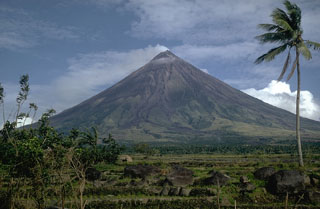Report on Mayon (Philippines) — 16 December-22 December 2009
Smithsonian Institution / US Geological Survey
Weekly Volcanic Activity Report, 16 December-22 December 2009
Managing Editor: Sally Sennert.
Please cite this report as:
Global Volcanism Program, 2009. Report on Mayon (Philippines) (Sennert, S, ed.). Weekly Volcanic Activity Report, 16 December-22 December 2009. Smithsonian Institution and US Geological Survey.
Mayon
Philippines
13.257°N, 123.685°E; summit elev. 2462 m
All times are local (unless otherwise noted)
PHIVOLCS reported that during 14-19 December sulfur dioxide emissions from Mayon fluctuated between 750 and 2,034 tonnes per day. During 15-16 December, detached fragments from lava accumulating in the summit crater traveled as far as 4 km down the SE-flank Bonga-Buyuan gully, and lava flows traveled 700-800 m. Occasionally detached lava fragments produced small pyroclastic surges down the SW flank that generated light ashfall 13 km S and W in Camalig and Guinobatan, respectively. Steam plumes rose 200 m above the crater rim and drifted SW and WSW. During 17-20 December the seismic network detected 66 explosion-type signals; only 23 events were seen during periods of good visibility. These explosions produced dark gray to dark brown ash plumes that rose 500-2,000 m above the crater rim and drifted SW. Harmonic tremor was detected by the seismic network. Brownish-colored steam and intensified incandescence at night were noted.
On 20 December lava flows had advanced 4.5 km from the crater. PHIVOLCS raised the Alert Level to 4 (on a scale of 0-5) and recommended that the Extended Danger Zone (EDZ) encompass an area 8 km S from the summit and 7 km N from the summit. During 20-22 December the rate and intensity of seismic signals dramatically increased. The sulfur dioxide emission rate also increased; 6,089-6,529 tonnes per day was measured. Booming and rumbling sounds, and intensified crater incandescence, were noted. Lava fountains rose 200 m above the crater and lava flowed as far as 5 km down the Bonga-Buyuan, Miisi, and Lidong gullies.
According to news articles, more than 47,000 people from 30 villages were in evacuation centers across Albay province. About 3,000-6,000 residents had not evacuated.
Geological Summary. Symmetrical Mayon, which rises above the Albay Gulf NW of Legazpi City, is the most active volcano of the Philippines. The steep upper slopes are capped by a small summit crater. Recorded eruptions since 1616 CE range from Strombolian to basaltic Plinian, with cyclical activity beginning with basaltic eruptions, followed by longer periods of andesitic lava flows. Eruptions occur predominately from the central conduit and have also produced lava flows that travel far down the flanks. Pyroclastic density currents and mudflows have commonly swept down many of the approximately 40 ravines that radiate from the summit and have often damaged populated lowland areas. A violent eruption in 1814 killed more than 1,200 people and devastated several towns.
Sources: Philippine Institute of Volcanology and Seismology (PHIVOLCS), Inquirer.net, Associated Press

